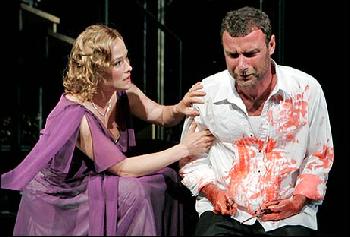SITE GUIDE
REVIEWS
FEATURES
NEWS
Etcetera and
Short Term Listings
LISTINGS
Broadway
Off-Broadway
NYC Restaurants
BOOKS and CDs
OTHER PLACES
Berkshires
London
California
DC
Philadelphia
Elsewhere
QUOTES
On TKTS
PLAYWRIGHTS' ALBUMS
LETTERS TO EDITOR
FILM
LINKS
MISCELLANEOUS
Free Updates
Masthead
Writing for Us
A CurtainUp Review
Macbeth
by Les
Gutman
|
I have no spur To prick the sides of my intent, but only Vaulting ambition, which o'erleaps itself And falls on the other. ---Macbeth, Act I, scene vii |
 J. Ehle and L. Schreiber
(Photo: Michal Daniel) |
There's nothing like a lazy, persistent rain to evoke Scotland. And that's what we had the night I saw this Macbeth. As it turns out, however, Moisés Kaufman's concept for this production had nothing to do with Scotland, and not much more to do with the complex dynamic that we commonly think of when we contemplate this work.
Kaufman is a fine director and writer, whose most successful work has been in documenting facts in fascinating ways in plays like Gross Indecency, The Laramie Project and, most recently, I Am My Own Wife. But Macbeth is not a play transported by its facts; its subject matter is psychology. The forces that propel the fast and furious action in this play are not as readily parsed as those in, say, Hamlet, or Richard III, but its critical.
To understand Macbeth, one must understand the title character (Liev Schreiber) and Lady Macbeth (Jennifer Ehle). We couldn't ask for a couple easier to listen to than Schreiber and Ehle. Both have the voice and the control of the language. What's absent almost entirely is any sense of Macbeth, the nobly loyal warrior who returns from battle to great glory, only to descend into villainy. What makes the play is his twin manipulation, by the Weird Sisters (here portrayed wonderfully by the trio of Joan MacIntosh, Ching Valdes-Aran and Lynn Cohen) and Lady Macbeth. Kaufman gets the Sisters right -- he even heaps on some extra layers of manipulation Shakespeare didn't contemplate. But the pull of Ms. Ehle's Lady is elusive. There is no passion in this marriage, and the defect is compounded by Shreiber's essential ambivalence, which makes his anxious, equivocal journey inexplicable. Ms. Ehle seems unsettled on what to make of Lady Macbeth, and only comes to find her shortly before her famous demise.
Beyond the central characters, the successes in the production are hit-or-miss, and the story-telling is often lacking. Jacob Fishel's Malcolm rises above the norm, but Teagle Bougere's Banquo is anemic -- compounded in the banquet scene by staging that makes Macbeth's madness strangely unfocused. Lynn Cohen performs double duty as the Porter, in a delightfully funny interlude. Other particular strong performances come from Pedro Pascal (as both the Bloody Sergeant and one of the murderers) and Graeme Malcolm as Seyton.
The production is set, somewhat vaguely, in the America of first half of the 20th Century. Its military aspects seem rooted in World War I, though at times there seems to be an urgent effort to connect them to current events as well. The social setting of the play conjures up the 1930's, or maybe it's the 40's. I am not one of those people who objects to the historic recharacterization of Shakespeare's plays, but I do expect an internal integrity in such choices, and here they seem like no more than window-dressing.
Derek McLane's set boasts a large open playing area, behind which he installed what might best be described as a dark blue drawing room wall, with a staircase leading to a door. These pieces moved up and back to adjust to scenes, and flew aside in time for the park's vegetation to aid the arrival of Birnam Wood at Dunsinane. David Lander provided moody lighting that was very effective, with an assist from an unusual 8:30 P.M. start time, which eliminated the frequent problem of lighting scenes before the last of the daylight was disappeared. Michael Krass's costumes, if you disregard my complaints about significance above, were well-executed and Acme Sound Partners did fine work in creating the desired atmospherics.
Whatever the ambitions of this production, they don't vault.
|
Macbeth
by William ShakespeareDirected by Moisés Kaufman with Tolan Aman, Teagle F. Bougere, Sterling K. Brown, Lynn Cohen, Sanjit De Silva, Seth Duerr, Jennifer Ehle, Amefika El-Amin, Stephanie Fieger, Jacob Fishel, Herb Foster, Phillip Goodwin, Hollie Hunt, Florencia Lozano, Joan MacIntosh, Graeme Malcolm, Michael Markham, Andrew McGinn, Mark Montgomery, Lucas Near-Verbrugghe, Clancy O'Connor, Pedro Pascal, Liev Schreiber and Ching Valdes-Aran Set Design: Derek McLane Costume Design: Michael Krass Lighting Design: David Lander Sound Design: Acme Sound Partners Composer: Peter Golub Fight Director: Rick Sordelet Running time: 2 hours, 20 minutes with 1 intermission A production of The Public Theater Delacorte Theatre, Central Park (enter park @81st Street/CPW or 79th/5 Av.) Telephone (212) 539-8750 Public Theater website: www.publictheater.org Opening July 28, 2006, closes July 9, 2006 Tues - Sun @8:30 (added performance Mon 7/3, no performance Tues 7/4; Free, limit of 2 per person (ticket pickup at the Delacorte or The Public beginning at 1 P.M. and elsewhere in all 5 boroughs on specified days -- see The Public Theater website) Reviewed by Les Gutman based on 6/23/06 performance |

6, 500 Comparative Phrases including 800 Shakespearean Metaphors by our editor.
Click image to buy.
Go here for details and larger image.






